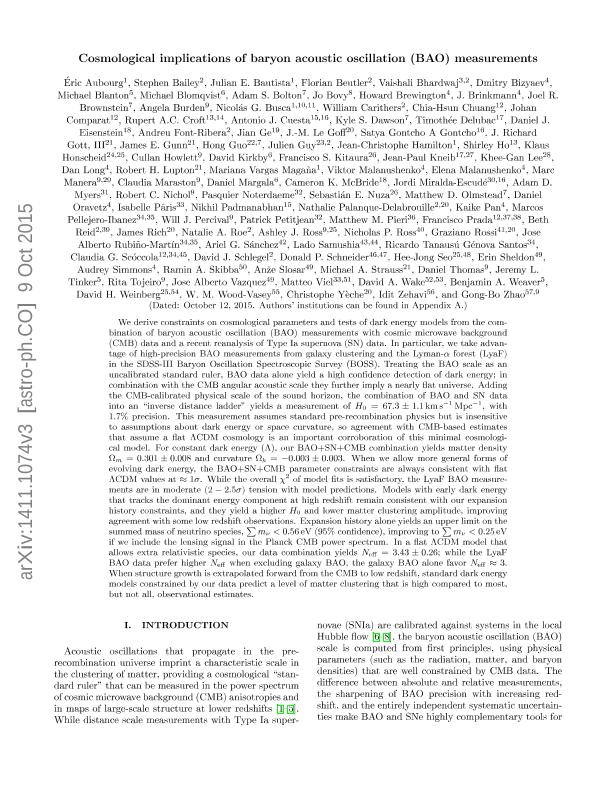Artículo
Cosmological implications of baryon acoustic oscillation measurements
Aubourg, Éric; Bailey, Stephen; Bautista, Julian; Beutler, Florian; Bhardwaj, Vaishali; Bizyaev, Dmitry; Blanton, Michael; Blomqvist, Michael; Bolton, Adam S.; Bovy, Jo; Brewington, Howard; Brinkmann, J.; Brownstein, Joel R.; Burden, Angela; Busca, Nicolás G.; Carithers, William; Chuang, Chia Hsun; Comparat, Johan; Croft, Rupert A. C.; Cuesta, Antonio J.; Dawson, Kyle S.; Delubac, Timothée; Eisenstein, Daniel J.; Font Ribera, Andreu; Ge, Jian; Le Goff, J. M.; Gontcho, Satya Gontcho A.; Gott, J. Richard; Nuza, Sebastian Ernesto ; Scoccola, Claudia Graciela
; Scoccola, Claudia Graciela
 ; Scoccola, Claudia Graciela
; Scoccola, Claudia Graciela
Fecha de publicación:
14/12/2015
Editorial:
American Physical Society
Revista:
Physical Review D: Particles, Fields, Gravitation and Cosmology
ISSN:
1550-7998
Idioma:
Inglés
Tipo de recurso:
Artículo publicado
Clasificación temática:
Resumen
We derive constraints on cosmological parameters and tests of dark energy models from the combination of baryon acoustic oscillation (BAO) measurements with cosmic microwave background (CMB) data and a recent reanalysis of Type Ia supernova (SN) data. In particular, we take advantage of high-precision BAO measurements from galaxy clustering and the Lyman-α forest (LyaF) in the SDSS-III Baryon Oscillation Spectroscopic Survey (BOSS). Treating the BAO scale as an uncalibrated standard ruler, BAO data alone yield a high confidence detection of dark energy; in combination with the CMB angular acoustic scale they further imply a nearly flat universe. Adding the CMB-calibrated physical scale of the sound horizon, the combination of BAO and SN data into an "inverse distance ladder" yields a measurement of H0=67.3±1.1 km s-1 Mpc-1, with 1.7% precision. This measurement assumes standard prerecombination physics but is insensitive to assumptions about dark energy or space curvature, so agreement with CMB-based estimates that assume a flat ΛCDM cosmology is an important corroboration of this minimal cosmological model. For constant dark energy (Λ), our BAO+SN+CMB combination yields matter density Ωm=0.301±0.008 and curvature Ωk=-0.003±0.003. When we allow more general forms of evolving dark energy, the BAO+SN+CMB parameter constraints are always consistent with flat ΛCDM values at ≈1σ. While the overall χ2 of model fits is satisfactory, the LyaF BAO measurements are in moderate (2-2.5σ) tension with model predictions. Models with early dark energy that tracks the dominant energy component at high redshift remain consistent with our expansion history constraints, and they yield a higher H0 and lower matter clustering amplitude, improving agreement with some low redshift observations. Expansion history alone yields an upper limit on the summed mass of neutrino species, mν<0.56 eV (95% confidence), improving to mν<0.25 eV if we include the lensing signal in the Planck CMB power spectrum. In a flat ΛCDM model that allows extra relativistic species, our data combination yields Neff=3.43±0.26; while the LyaF BAO data prefer higher Neff when excluding galaxy BAO, the galaxy BAO alone favor Neff≈3. When structure growth is extrapolated forward from the CMB to low redshift, standard dark energy models constrained by our data predict a level of matter clustering that is high compared to most, but not all, observational estimates.
Archivos asociados
Licencia
Identificadores
Colecciones
Articulos(CCT - LA PLATA)
Articulos de CTRO.CIENTIFICO TECNOL.CONICET - LA PLATA
Articulos de CTRO.CIENTIFICO TECNOL.CONICET - LA PLATA
Citación
Aubourg, Éric; Bailey, Stephen; Bautista, Julian; Beutler, Florian; Bhardwaj, Vaishali; et al.; Cosmological implications of baryon acoustic oscillation measurements; American Physical Society; Physical Review D: Particles, Fields, Gravitation and Cosmology; 92; 12; 14-12-2015; 1-39
Compartir
Altmétricas



